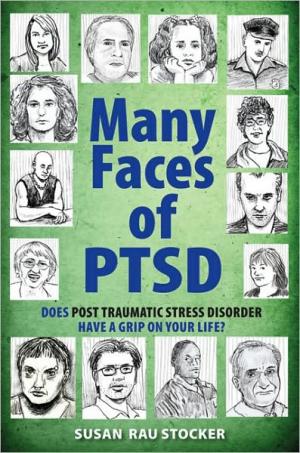Many Faces of PTSD: Does Post Traumatic Stress Disorder Have a Grip On Your Life?

This small, compact book is a treasure. I don’t mean that post-traumatic stress disorder (PTSD) is great; on the contrary, it’s a long-term battle once you’ve been diagnosed with it. The book itself, though, is a good read, considering the subject matter, and Many Faces of PTSD is much bigger than its 124-page size.
Therapist Susan Rau Stocker presents various case studies in a nonjudgmental format that tugs at the reader emotionally while at the same time offering coping mechanisms for PTSD. Through the case of “Olivia,” we are given the example of a person with PTSD who suffers from anxiety and generational family abuse. This causes Olivia to question her sanity and self-esteem. The reader is given Olivia's PTSD symptoms and the effects they have on her body and mind. As one of Stocker’s patients, she is trying to come to grips with how to function on the day-to-day, and become as stable as possible. It is a work in progress, and there is no quick fix.
Despite the grim reality of the recovery process, Stocker’s offerings of healing are very positive. It may be a lot of work, but it is all worth it. From initially accepting that the sufferer has PTSD (which is the most difficult step towards healing) to recognizing personal maladaptive behaviours and coming up with alternative solutions, the path to recovery can be overwhelming. Many Faces of PTSD patiently shows that the path can eventually lead to better lives.
Part of the challenge in accepting life with PTSD are the limitations it comes with. As Stocker notes, the disorder is neurological; the brain malfunctions. Each patient is different and the book covers many different factors, including medication. One of the elements of recovery that was not covered, however, was the diet of the person with PTSD. What we eat is crucial not only because of the old saying, "we are what we eat," but because sufferers must pay attention to caffeine and sugar intake, which can affect symptoms like anxiety. It can’t be held against the author, though, since she presents her findings and tips derived from therapy sessions.
In the end, as Stocker notes, it really is up to the person with PTSD to take control over her or his healing process. While some of the case studies are uncomfortable, reading through them is therapeutic. I was only able to read one a night, instead of sitting down with the book all at one time, and found that the goal of transitioning from victim to active survivor is possible for those willing and able to put in the effort.